Compared: M2 MacBook Air versus Microsoft Surface Laptop 5
Microsoft's Surface Laptop 5 is a thin and powerful Windows notebook in the same market segment as Apple's MacBook Air. Here's how the two compare.
![Microsoft Surface Laptop 5 [left], Apple M2 MacBook Air [right]](https://photos5.appleinsider.com/gallery/50849-100415-surface-laptop-5-m2-macbook-air-header-xl.jpg)
Microsoft Surface Laptop 5 [left], Apple M2 MacBook Air [right]
Microsoft's refresh of its hardware lineup included quite a few staples, including the Surface Pro 9 and the Surface Studio 2 Plus. Alongside the tablet and iMac competitor was the Surface Laptop 5, a continuation of Microsoft's notebook family that promises performance in a compact computing setup.
The marketing claims for the notebook boast about its "sleek" appearance, all-day battery life, and multitasking speed through its 12th-gen Intel chips.
It's only natural that such a notebook gets put against the M2 MacBook Air, Apple's entry-level notebook that also offers a compact appearance and bags of performance.
Microsoft has a thing for including fabrics in its Surface devices, and the Surface Laptop 5 is no exception. Alongside typical aluminum enclosures, there's an option available for Alcantara, a microfiber-like cloth directly attached to the notebook's wrist rest.
Apple uses aluminum for its MacBook Air, with four colors: Silver, Starlight, Space Gray, and Midnight. Microsoft opts for Sandstone, Black, Sage, and Platinum Alcantara for its 13.5-inch model, plus Platinum and Black for its larger variant.
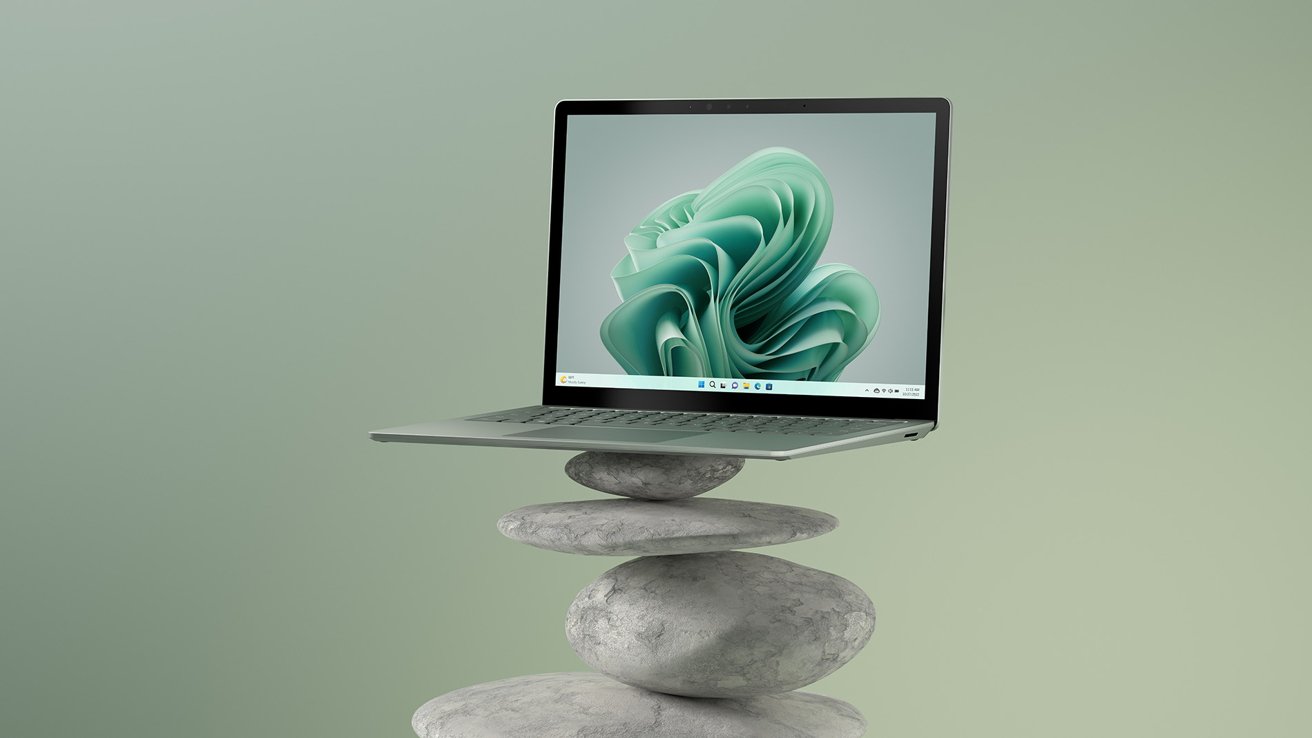
The Surface Laptop 5 is thin and light, but the MacBook Air is thinner and lighter still.
The MacBook Air has a compact 11.97 inches by 8.46 inches footprint, far smaller than the Microsoft counterparts. The 13.5-inch Surface Laptop 5 is 12.1 inches by 8.8 inches, while the 15-inch is 13.4 inches by 9.6 inches.
The MacBook Air is 0.44 inches thick, versus 0.57 and 0.58 inches for the 13.5-inch and 15-inch Surface Laptop models.
Apple leads again with 2.7 pounds to the 2.8 pounds of the 13.5-inch Surface Laptop 5 in a fabric finish and 2.86 pounds for metal only. The 15-inch is the heaviest at 3.44 pounds.
The resolution of 2,560 by 1,664 gives it a pixel density of 224 pixels per inch, which is typical for Apple's notebooks.
Where the display differs from the usual notebook screen is Apple's use of a notch, borrowed from the iPhone lineup, to create thin bezels while accommodating the camera. This did lead to criticism from some not wanting part of the screen blocked off, but since it only really eats into the main menu bar, it's not a real problem.
When an app is displayed full-screen, the image stops below the notch, so the picture isn't cut off, and black spaces at the top of the screen on either side hides the void.
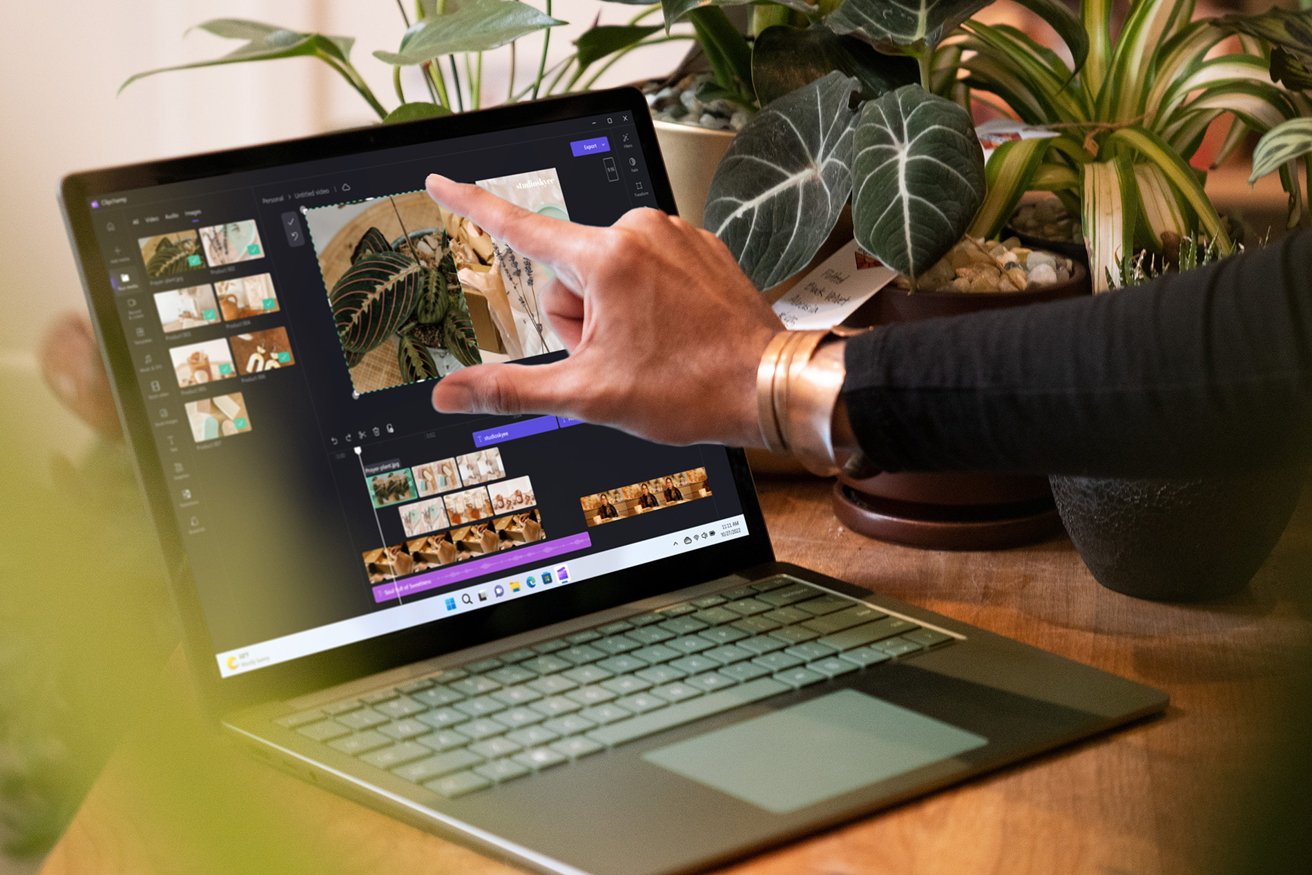
The Surface Laptop 5 has a multitouch-enabled display, which also works with a stylus.
Microsoft tends to go down a different route for its notebook displays, with the 13.5-inch and 15-inch PixelSense displays operating in a 3:2 aspect ratio. This results in a much squarer display than the MacBook Air, which manages the traditional 16:10 for full-screen images below the menu bar.
The 13.5-inch model has a resolution of 2,256 by 1,504, while the 15-inch manages 2,496 by 1,664. These result in a pixel density of 201ppi, which isn't quite to Apple's standard.
Microsoft doesn't say what the brightness of its screens is, but it's likely to be similar to the MacBook Air. It does offer a contrast ratio of 1,300:1, which is in the same ballpark as the Air.
The Surface Laptop's screens are individually color-calibrated, with color profiles for sRGB and Vivid. Dolby Vision IQ support is also available, which can fine-tune the colors during the playback of media.
Where Microsoft pulls ahead is that the displays have ten-point multitouch support. The MacBook lineup has never offered this, and the nearest you could get would be an iPad Pro on a Magic Keyboard.
That screen also supports the Surface Pen, a stylus that, again, Apple cannot match unless you look at turning an iPad into a notebook.
Both benefit from a 16-core Neural Engine for machine learning-related tasks and the Media Engine. Borrowed from the M1 Pro and M1 Max, the Media Engine consists of dedicated video decode and encode engines for H.264, HEVC, ProRes, and ProRes RAW.
Microsoft has two different chips at its disposal for the Surface Laptop 5. They are Intel Evo 12th-generation chips, with the 13.5 configurable with both, while the 15-inch uses just the higher-tier one.
One is the Core i5-1235U, a 10-core, 12-thread chip with two performance cores with a max turbo of 4.40GHz, and eight efficient cores capable of 3.30GHz.
The other is the Core i7-1255U, another 10-core, 12-thread processor with two 4.70GHz performance cores and eight 3.50GHz efficient cores.
For graphics, the Surface Laptop 5 relies on Intel Iris XE, namely integrated graphics.
Benchmarks for the Core i7 model of Surface Laptop indicate Intel's chip fares quite well against the M2. In GeekBench's single-core the Core i7 manages around 1,640 while the multi-core score is about 8,970. By contrast, the M2 manages a single-core score of 1,898 and a multi-core score of 8,547.
You would've thought that with the number of cores, the Core i7 would do a lot better, but it doesn't.
For graphics, benchmarks for the Surface Laptop 5 putting it at 17,800 for GeekBench's OpenCL graphics test. However, the M2 scores around 27,200, considerably more. Apple said the GPU in the M2 is faster by 35% than the M1, and so far, that seems to be true.
The 2020 M1 MacBook Air scored 18,282, still higher than the Iris XE score in 2022.
This all doesn't take into account the Core i5, which will naturally have lower scores than the Core i7. Even so, while the Core i7 does narrowly win on multi-core processing, the M2 still dominates the rest.
Apple uses the FaceTime HD camera, a 1080p imaging component that also benefits from Apple Silicon's image signal processing. It's housed in the notch at the top of the display.
Microsoft uses a 720p camera, a lower-resolution device embedded in the bezel. However, rather than just working as a webcam, it also supports Microsoft's Windows Hello biometric system.
The camera includes IR sensing capabilities, providing more accurate readings than a flat picture for facial recognition.
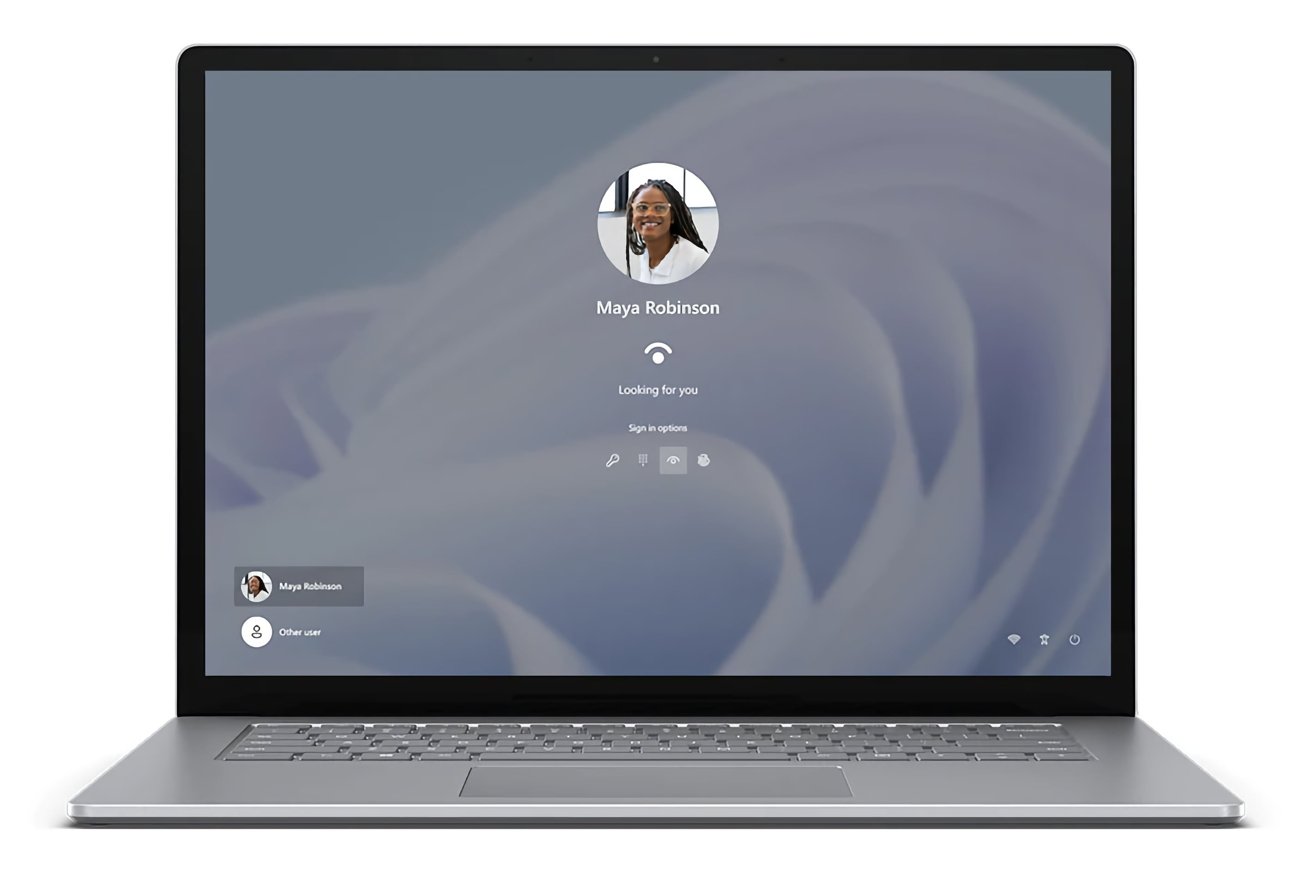
While not 1080p, the 720p webcam in the Surface Laptop 5 has IR support, enabling Windows Hello.
Apple doesn't do Face ID in its notebooks, but it does have a dedicated Touch ID button on its keyboard.
The MacBook Air has two Thunderbolt/USB 4 ports, as well as a headphone jack, and a MagSafe 3 port. The latter enables recharging without occupying one of the two scarce Thunderbolt connections.
Microsoft also uses Thunderbolt/USB 4, but only for a single port. It does, however, include a USB-A 3.1 port, which could be handy for older accessories.
The Surface Laptop 5 also has a Surface Connect port, which is used for power adapters, docks, and other hardware.
Apple's audio includes a four-speaker system and a three-mic array with dynamic beamforming.
Microsoft uses "Omnisonic speakers," which in this case, are dual stereo speakers. They are paired with dual far-field Studio microphones.
Both product families include Dolby Atmos support, which the MacBook Air uses for Spatial Audio.
The MacBook Air is capable of up to 15 hours of wireless web access, or up to 18 hours of Apple TV app movie playback from a single charge, using its 52.6Wh battery.
Microsoft claims its 13.5-inch model can manage up to 18 hours "of typical device usage," while the 15-inch can handle up to 17 hours. This typical usage refers to a "mixture of active use and modern standby," including web browsing, productivity tools, and idle applications.
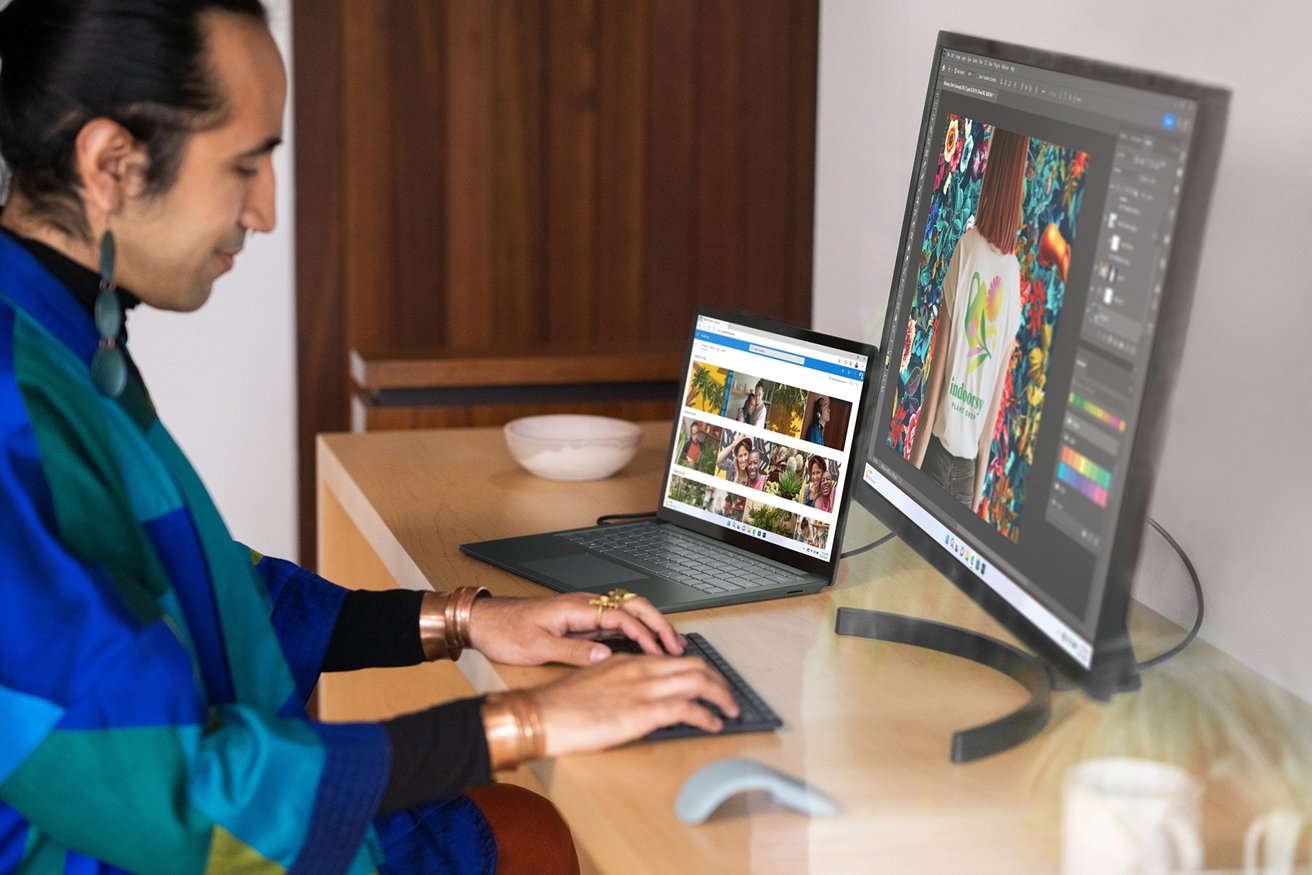
Up to 18 hours of battery life is claimed by Microsoft.
Microsoft doesn't state what power supply the Surface Laptop 5 uses, but Apple does. It includes a 30W USB-C Power Adapter with its 8-Core GPU variant, with the 10-core 512GB model upgraded to a 35W Dual USB-C Port Compact Power Adapter, though you could also go for a 67W one as well.
Microsoft starts with 8GB, with 16GB and 32GB options available in its store.
For storage, Apple offers 256GB as the base option, with 512GB, 1TB, and 2TB SSDs optional.
Microsoft starts at 256GB for its SSD storage, rising to 512GB and 1TB at its highest. However, it does mark the drives as "removable."
This apparently consists of "Customer Replaceable Units" purchasable from authorized dealers, and while you can install it yourself, Microsoft does point out that its technicians can do it for you.
There are no post-purchase upgrades available for the MacBook Air.
Upgrading to the 10-core GPU is an extra $100, while 16GB and 32GB memory upgrades from the base are $200 and $400, respectively. The 512GB, 1TB, and 2TB storage upgrades are $200, $400, and $800 respectively.
The power adapter upgrades are $20 from the 30W, but you can get either the 35W dual USB-C or 67W for that.
At the most expensive configuration, an M2 MacBook Air costs $2,499.
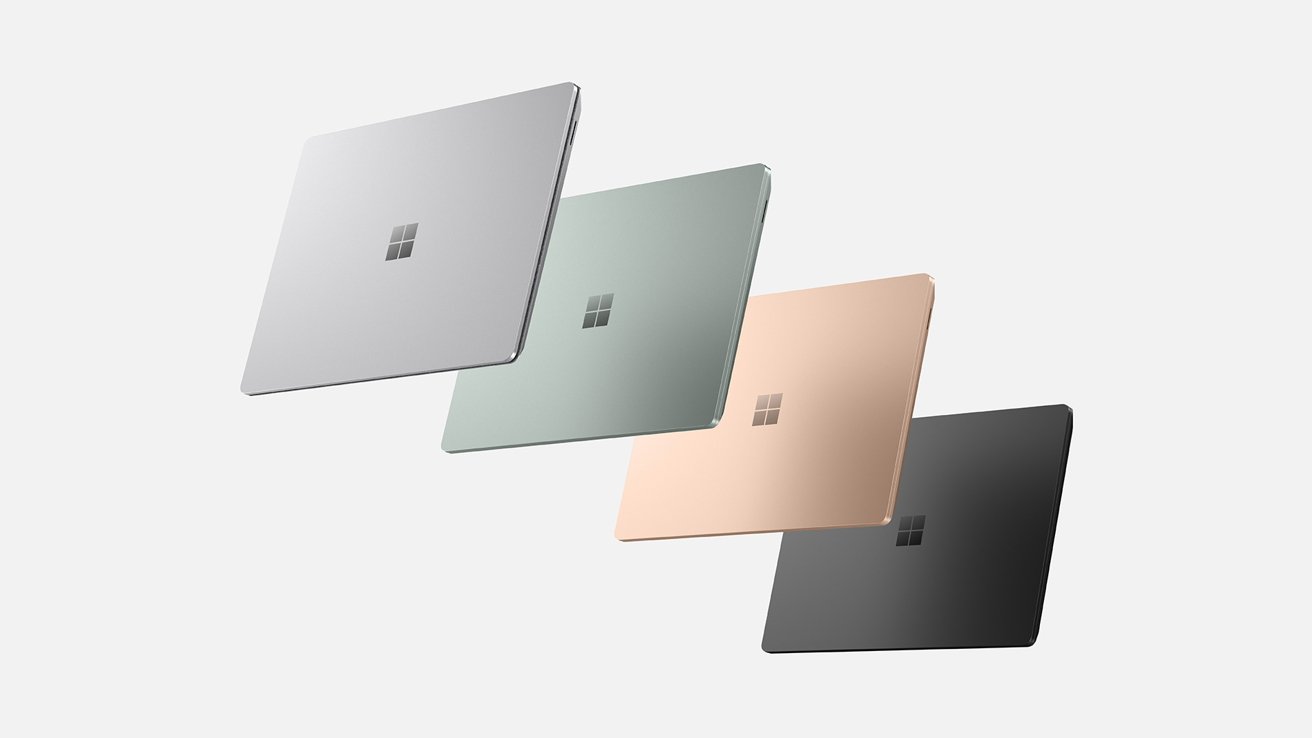
The color range of the Surface Laptop 5.
Microsoft sells eight configurations of the Surface Laptop 5, with four of each display size on offer.
The 13.5-inch starts at $999.99 for the Core i5, 8GB of RAM, and 256GB SSD, with the 512GB SSD version an increase to $1,299.99. The Core i5 with 16GB of memory and 512GB of storage is $1,499.99, while the Core i7 with 16GB of memory and 512GB of storage is $1,699.99.
For the 15-inch, you have the Core i7 with 8GB of memory and 256GB of storage for $1,299.99, rising to $1,499.99 for 512GB of storage. Going for 16GB of memory and 512GB of storage is $1,799.99, but going for 32GB of memory and 1TB of storage pushes the price to $2,399.
That it has a multitouch display and stylus support is a crucial bonus.
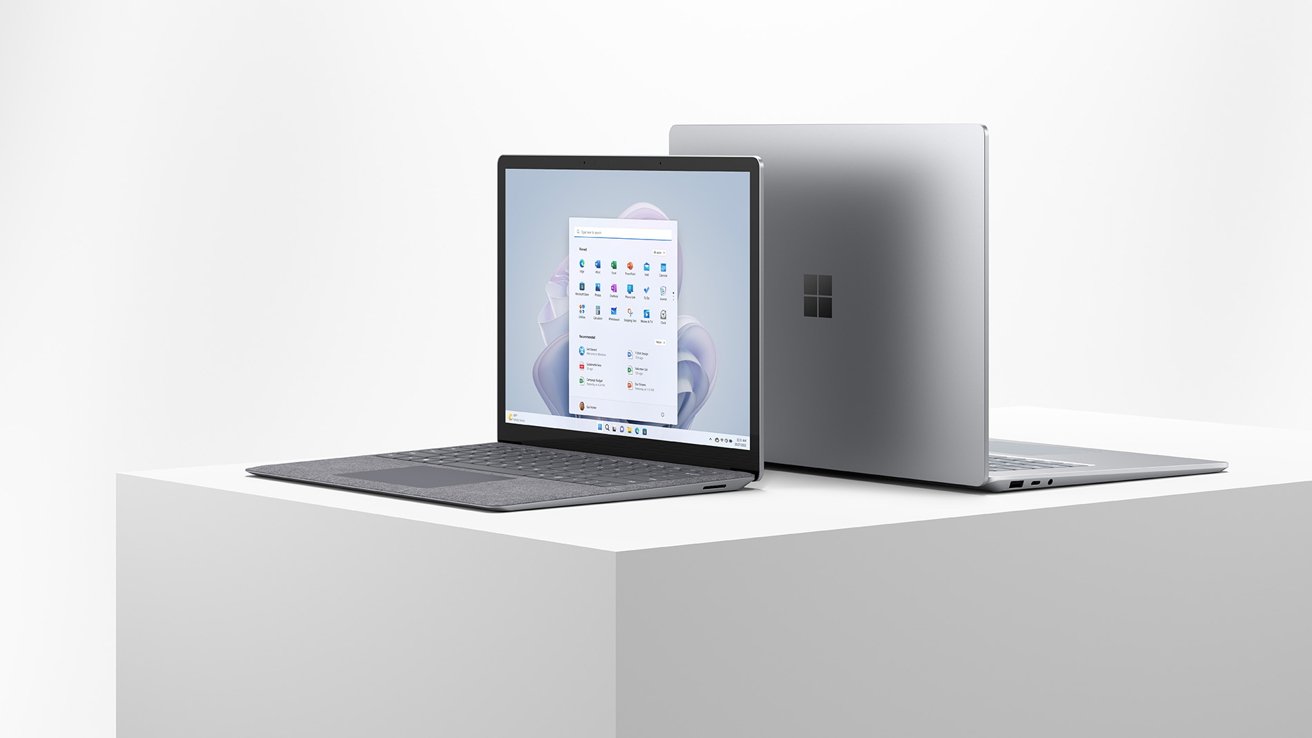
You can get the Surface Laptop 5 in 13.5-inch and 15-inch varieties.
With the M2 MacBook Air, Apple has produced a thinner, smaller notebook that does the same thing.
One that also offers masses more performance than the Surface Laptop 5's Intel chips. One with a higher pixel density display and even a higher-resolution webcam to play with.
The only things that make the Surface Laptop 5 more attractive than the MacBook Air is the price and the touch-enabled screen. And the latter's only a problem if you're dead set against using an iPad Pro as your primary computing device.
The Surface Laptop 5 has a lot going for it. In a software-agnostic comparison, the M2 MacBook Air does much of that stuff better.
On the Microsoft side, the Surface Laptop 5 starts at $999 for the 13.5-inch version and can be ordered from Microsoft directly. Available upgrades include bumps to 16GB of RAM, 512GB of storage, and a Core i7 processor.
The larger 15-inch Surface Laptop 5 starts at $1,299.99 and tops out at $2,399.99 when ordered directly from Microsoft. Retailers Amazon and Best Buy also stock the 15-inch configurations.
Read on AppleInsider
![Microsoft Surface Laptop 5 [left], Apple M2 MacBook Air [right]](https://photos5.appleinsider.com/gallery/50849-100415-surface-laptop-5-m2-macbook-air-header-xl.jpg)
Microsoft Surface Laptop 5 [left], Apple M2 MacBook Air [right]
Microsoft's refresh of its hardware lineup included quite a few staples, including the Surface Pro 9 and the Surface Studio 2 Plus. Alongside the tablet and iMac competitor was the Surface Laptop 5, a continuation of Microsoft's notebook family that promises performance in a compact computing setup.
The marketing claims for the notebook boast about its "sleek" appearance, all-day battery life, and multitasking speed through its 12th-gen Intel chips.
It's only natural that such a notebook gets put against the M2 MacBook Air, Apple's entry-level notebook that also offers a compact appearance and bags of performance.
Surface Laptop 5 vs M2 MacBook Air - Specifications
| Specifications | MacBook Air (2022, M2) | Microsoft Surface Laptop 5 (13.5-inch) | Microsoft Surface Laptop 5 (15-inch) |
|---|---|---|---|
| Starting Price | $1,199 Best M2 MacBook Air prices | $999 | $1,299 |
| Dimensions (inches) | 11.97 x 8.46 x 0.44 | 12.1 x 8.8 x 0.57 | 13.4 x 9.6 x 0.58 |
| Weight (pounds) | 2.7 | 2.8 (Fabric), 2.86 (Metal) | 3.44 |
| Display | 13.6-inch Liquid Retina, Wide Color (P3), True Tone | 13.5-inch 3:2 PixelSense, sRGB and Vivid profiles, Dolby Vision IQ support 10-point Multitouch | 15-inch 3:2 PixelSense display, sRGB and Vivid profiles, Dolby Vision IQ support, 10-point Multitouch |
| Resolution | 2,560 x 1,664 | 2,256 x 1,504 | 2,496 x 1664 |
| Processor | Apple M2 | 12th-gen Intel Core i5-1235U, 12th-gen Intel Core i7-1255U | 12th-gen Intel Core i7-1255U |
| Graphics | 8-core GPU, 10-core GPU | Intel Iris Xe | Intel Iris XE |
| Memory | 8GB, 16GB, 24GB | 8GB, 16GB, 32GB | 8GB, 16GB, 24GB |
| Storage | 256GB, 512GB, 1TB, 2TB | 256GB, 512GB, 1TB | 256GB, 512GB, 1TB |
| Battery | 52.6Wh lithium-polymer, Up to 15 hours web, 18 hours video | Up to 18 hours of typical usage | Up to 17 hours of typical usage |
| Networking | 802.11ax Wi-Fi 6 Bluetooth 5.0 | 802.11ax Wi-Fi, Bluetooth 5.1 | 802.11ax Wi-Fi, Bluetooth 5.1 |
| Security | Touch ID | Windows Hello | Windows Hello |
| Camera | 1080p FaceTime HD | 720p HD | 720p HD IR |
| Audio | Four-speaker sound system, Three-mic array with directional beamforming, Headphone jack with high-impedance headphone support, Dolby Atmos support with Spatial Audio | Omnisonic speakers, Dolby Atmos, Headphone jack, Dual far-field Studio microphones | Omnisonic speakers, Dolby Atmos, Headphone jack, Dual far-field Studio microphones |
| Ports | Two Thunderbolt/USB 4, 3.5mm headphone, MagSafe 3 | Thunderbolt 4/USB 4, USB-A 3.1, 3.5mm headphone, Surface Connect | Thunderbolt 4/USB 4, USB-A 3.1, 3.5mm headphone, Surface Connect |
Surface Laptop 5 vs M2 MacBook Air - Physical Features
Microsoft has included two sizes of Surface Laptop 5, with a 13.5-inch model alongside a 15-inch version. Apple only offers a 13-inch MacBook Air, so you'll have to look at other models if you want a bigger display.Microsoft has a thing for including fabrics in its Surface devices, and the Surface Laptop 5 is no exception. Alongside typical aluminum enclosures, there's an option available for Alcantara, a microfiber-like cloth directly attached to the notebook's wrist rest.
Apple uses aluminum for its MacBook Air, with four colors: Silver, Starlight, Space Gray, and Midnight. Microsoft opts for Sandstone, Black, Sage, and Platinum Alcantara for its 13.5-inch model, plus Platinum and Black for its larger variant.

The Surface Laptop 5 is thin and light, but the MacBook Air is thinner and lighter still.
The MacBook Air has a compact 11.97 inches by 8.46 inches footprint, far smaller than the Microsoft counterparts. The 13.5-inch Surface Laptop 5 is 12.1 inches by 8.8 inches, while the 15-inch is 13.4 inches by 9.6 inches.
The MacBook Air is 0.44 inches thick, versus 0.57 and 0.58 inches for the 13.5-inch and 15-inch Surface Laptop models.
Apple leads again with 2.7 pounds to the 2.8 pounds of the 13.5-inch Surface Laptop 5 in a fabric finish and 2.86 pounds for metal only. The 15-inch is the heaviest at 3.44 pounds.
Surface Laptop 5 vs M2 MacBook Air - Display
Apple users will be very familiar with the display used in the MacBook Air. It's an LED-backlit 13.6-inch screen, offering 500 nits of brightness, Wide Color (P3) support, and True Tone.The resolution of 2,560 by 1,664 gives it a pixel density of 224 pixels per inch, which is typical for Apple's notebooks.
Where the display differs from the usual notebook screen is Apple's use of a notch, borrowed from the iPhone lineup, to create thin bezels while accommodating the camera. This did lead to criticism from some not wanting part of the screen blocked off, but since it only really eats into the main menu bar, it's not a real problem.
When an app is displayed full-screen, the image stops below the notch, so the picture isn't cut off, and black spaces at the top of the screen on either side hides the void.
The Surface Laptop 5 has a multitouch-enabled display, which also works with a stylus.
Microsoft tends to go down a different route for its notebook displays, with the 13.5-inch and 15-inch PixelSense displays operating in a 3:2 aspect ratio. This results in a much squarer display than the MacBook Air, which manages the traditional 16:10 for full-screen images below the menu bar.
The 13.5-inch model has a resolution of 2,256 by 1,504, while the 15-inch manages 2,496 by 1,664. These result in a pixel density of 201ppi, which isn't quite to Apple's standard.
Microsoft doesn't say what the brightness of its screens is, but it's likely to be similar to the MacBook Air. It does offer a contrast ratio of 1,300:1, which is in the same ballpark as the Air.
The Surface Laptop's screens are individually color-calibrated, with color profiles for sRGB and Vivid. Dolby Vision IQ support is also available, which can fine-tune the colors during the playback of media.
Where Microsoft pulls ahead is that the displays have ten-point multitouch support. The MacBook lineup has never offered this, and the nearest you could get would be an iPad Pro on a Magic Keyboard.
That screen also supports the Surface Pen, a stylus that, again, Apple cannot match unless you look at turning an iPad into a notebook.
Surface Laptop 5 vs M2 MacBook Air - Processing and Performance
Apple uses the M2 chip in its MacBook Air, which has an 8-core CPU with four performance cores and four efficiency cores. There are two variants of the chip, one using Apple's 8-core GPU and the other the 10-core GPU.Both benefit from a 16-core Neural Engine for machine learning-related tasks and the Media Engine. Borrowed from the M1 Pro and M1 Max, the Media Engine consists of dedicated video decode and encode engines for H.264, HEVC, ProRes, and ProRes RAW.
Microsoft has two different chips at its disposal for the Surface Laptop 5. They are Intel Evo 12th-generation chips, with the 13.5 configurable with both, while the 15-inch uses just the higher-tier one.
One is the Core i5-1235U, a 10-core, 12-thread chip with two performance cores with a max turbo of 4.40GHz, and eight efficient cores capable of 3.30GHz.
The other is the Core i7-1255U, another 10-core, 12-thread processor with two 4.70GHz performance cores and eight 3.50GHz efficient cores.
For graphics, the Surface Laptop 5 relies on Intel Iris XE, namely integrated graphics.
Benchmarks for the Core i7 model of Surface Laptop indicate Intel's chip fares quite well against the M2. In GeekBench's single-core the Core i7 manages around 1,640 while the multi-core score is about 8,970. By contrast, the M2 manages a single-core score of 1,898 and a multi-core score of 8,547.
You would've thought that with the number of cores, the Core i7 would do a lot better, but it doesn't.
For graphics, benchmarks for the Surface Laptop 5 putting it at 17,800 for GeekBench's OpenCL graphics test. However, the M2 scores around 27,200, considerably more. Apple said the GPU in the M2 is faster by 35% than the M1, and so far, that seems to be true.
The 2020 M1 MacBook Air scored 18,282, still higher than the Iris XE score in 2022.
This all doesn't take into account the Core i5, which will naturally have lower scores than the Core i7. Even so, while the Core i7 does narrowly win on multi-core processing, the M2 still dominates the rest.
Surface Laptop 5 vs M2 MacBook Air - Cameras and Biometrics
Both notebook ranges have a webcam, an essential element of modern-day computing and video conferencing.Apple uses the FaceTime HD camera, a 1080p imaging component that also benefits from Apple Silicon's image signal processing. It's housed in the notch at the top of the display.
Microsoft uses a 720p camera, a lower-resolution device embedded in the bezel. However, rather than just working as a webcam, it also supports Microsoft's Windows Hello biometric system.
The camera includes IR sensing capabilities, providing more accurate readings than a flat picture for facial recognition.

While not 1080p, the 720p webcam in the Surface Laptop 5 has IR support, enabling Windows Hello.
Apple doesn't do Face ID in its notebooks, but it does have a dedicated Touch ID button on its keyboard.
Surface Laptop 5 vs M2 MacBook Air - Connectivity
Both notebooks offer 802.11ax Wi-Fi 6 support for wireless connectivity, but while Microsoft uses Bluetooth 5.1, Apple goes for Bluetooth 5.0.The MacBook Air has two Thunderbolt/USB 4 ports, as well as a headphone jack, and a MagSafe 3 port. The latter enables recharging without occupying one of the two scarce Thunderbolt connections.
Microsoft also uses Thunderbolt/USB 4, but only for a single port. It does, however, include a USB-A 3.1 port, which could be handy for older accessories.
The Surface Laptop 5 also has a Surface Connect port, which is used for power adapters, docks, and other hardware.
Surface Laptop 5 vs M2 MacBook Air - Audio
The headphone jack continues to be a mainstay in notebooks, with each having one. However, Apple includes high-impedance headphone support, which will work well with high-fidelity headphones.Apple's audio includes a four-speaker system and a three-mic array with dynamic beamforming.
Microsoft uses "Omnisonic speakers," which in this case, are dual stereo speakers. They are paired with dual far-field Studio microphones.
Both product families include Dolby Atmos support, which the MacBook Air uses for Spatial Audio.
Surface Laptop 5 vs M2 MacBook Air - Power
Both Apple and Microsoft boast of day-long battery life, using different criteria.The MacBook Air is capable of up to 15 hours of wireless web access, or up to 18 hours of Apple TV app movie playback from a single charge, using its 52.6Wh battery.
Microsoft claims its 13.5-inch model can manage up to 18 hours "of typical device usage," while the 15-inch can handle up to 17 hours. This typical usage refers to a "mixture of active use and modern standby," including web browsing, productivity tools, and idle applications.

Up to 18 hours of battery life is claimed by Microsoft.
Microsoft doesn't state what power supply the Surface Laptop 5 uses, but Apple does. It includes a 30W USB-C Power Adapter with its 8-Core GPU variant, with the 10-core 512GB model upgraded to a 35W Dual USB-C Port Compact Power Adapter, though you could also go for a 67W one as well.
Surface Laptop 5 vs M2 MacBook Air - Memory and Storage
Apple offers three options for memory and four for storage. The Unified Memory options start at 8GB, with 16GB and 24GB versions also available.Microsoft starts with 8GB, with 16GB and 32GB options available in its store.
For storage, Apple offers 256GB as the base option, with 512GB, 1TB, and 2TB SSDs optional.
Microsoft starts at 256GB for its SSD storage, rising to 512GB and 1TB at its highest. However, it does mark the drives as "removable."
This apparently consists of "Customer Replaceable Units" purchasable from authorized dealers, and while you can install it yourself, Microsoft does point out that its technicians can do it for you.
There are no post-purchase upgrades available for the MacBook Air.
Surface Laptop 5 vs M2 MacBook Air - Pricing
The M2 MacBook Air starts at $1,199 with the 8-core GPU version, 8GB of memory, 256GB of storage, and the 30W power adapter.Upgrading to the 10-core GPU is an extra $100, while 16GB and 32GB memory upgrades from the base are $200 and $400, respectively. The 512GB, 1TB, and 2TB storage upgrades are $200, $400, and $800 respectively.
The power adapter upgrades are $20 from the 30W, but you can get either the 35W dual USB-C or 67W for that.
At the most expensive configuration, an M2 MacBook Air costs $2,499.

The color range of the Surface Laptop 5.
Microsoft sells eight configurations of the Surface Laptop 5, with four of each display size on offer.
The 13.5-inch starts at $999.99 for the Core i5, 8GB of RAM, and 256GB SSD, with the 512GB SSD version an increase to $1,299.99. The Core i5 with 16GB of memory and 512GB of storage is $1,499.99, while the Core i7 with 16GB of memory and 512GB of storage is $1,699.99.
For the 15-inch, you have the Core i7 with 8GB of memory and 256GB of storage for $1,299.99, rising to $1,499.99 for 512GB of storage. Going for 16GB of memory and 512GB of storage is $1,799.99, but going for 32GB of memory and 1TB of storage pushes the price to $2,399.
Not quite matching the MacBook Air
On paper, the Surface Laptop 5 is reasonably thin, offers a high-resolution screen, and has decent performance for your all-day computing needs.That it has a multitouch display and stylus support is a crucial bonus.

You can get the Surface Laptop 5 in 13.5-inch and 15-inch varieties.
With the M2 MacBook Air, Apple has produced a thinner, smaller notebook that does the same thing.
One that also offers masses more performance than the Surface Laptop 5's Intel chips. One with a higher pixel density display and even a higher-resolution webcam to play with.
The only things that make the Surface Laptop 5 more attractive than the MacBook Air is the price and the touch-enabled screen. And the latter's only a problem if you're dead set against using an iPad Pro as your primary computing device.
The Surface Laptop 5 has a lot going for it. In a software-agnostic comparison, the M2 MacBook Air does much of that stuff better.
Where to buy the Surface Laptop 5 vs MacBook Air M2
Apple's 2022 MacBook Air is currently on sale for up to $150 off, with every configuration discounted (along with AppleCare) in our MacBook Air M2 Price Guide. You can also compare top offers in our MacBook Air deals roundup.On the Microsoft side, the Surface Laptop 5 starts at $999 for the 13.5-inch version and can be ordered from Microsoft directly. Available upgrades include bumps to 16GB of RAM, 512GB of storage, and a Core i7 processor.
The larger 15-inch Surface Laptop 5 starts at $1,299.99 and tops out at $2,399.99 when ordered directly from Microsoft. Retailers Amazon and Best Buy also stock the 15-inch configurations.
Read on AppleInsider

Comments
Gotta give it to Microsoft... the Surface lineup is pretty darn solid! I would never buy one (I don't do Windows™), but happy that there's some serious competition to keep Apple on their toes.
the dragonfly is a work issue machine. They went with the dragonfly after giving up trying to foist surface pros with keyboard on us. No one went for a second one. Just didn’t fit well with the majority’s use case. And those that did insisted on an iPad which as everyone has iPhones, was hard to say no to, much harder than a MacBook, which you can forget about.
https://www.statista.com/statistics/276308/global-apple-mac-sales-since-fiscal-year-2002/
The Surface Laptop is basically a Macbook Air wedge form factor clone, with straight lines instead of tapering. MS has their take with ports and dock and stuff, but the whole Apple design ethos is there with the Surface Laptop. MS is also one of the vendors, the only vendor?, that is using 200 to 250 DPI displays, This is right in the same range Apple uses for laptops and tablets too. So, the text size and clarity is about the same. Other Windows laptops are basically at <150 DPI or >300 DPI. Definitely targeted for that Mac laptop demographic.
Apple Silicon has given Mac laptops advantages that Intel won't be able to match until either TSMC messes up or Intel catches up. So, Apple is going to win the performance per noise, heat, and runtime level sweepstakes for a while. They have an advantage to wedge into more unit share. Not much Windows OEMs can do about it other to hit a form factor home run that Apple is hesitant to go into.
OLED folding laptops is the next form factor that will attempt to carve a niche in the market. It's going to be tough going if prices don't go down on them though. Apple is a pretty conservative on trying different form factors, and they could be surprised.
so what this article is saying is that the best Microsoft can do completely sucks conpared to the least apple can do….
why does the surface exist again?
It's a shame the article didn't compare heat / fan noise etc.
The M1 and m2 chips are amazing.
A big problem for me (at least) is now I can't run x86 VMs....
From an article here on AppleInsider:
But I believe the OS plays a big part of it too.
I have a Windows laptop for work (a year-old Dell). I run the same programs on my MacBook Pros (one Intel, one M1 pro) and the Dell. Namely, a browser, MS Office apps, PyCharm, DBeaver, text editors, and misc. others. I leave all three running 24x7, with at least half a dozen applications open and dozens of documents/windows. The MacBooks sit there quietly sipping power; the Dell often has the fan kick in when I'm doing nothing. The 2 culprits for bad power consumption on my Mac are Steam and Gmail via Safari. I have to quit and restart Safari every few days to stop Gmail from hogging my CPU.
When I close my MacBook, I can trust that the battery will be about the same whether I open it in an hour or a day. With the Windows laptop, I can expect a significant power drain after a few hours, and it will likely be at 0% after 24 hours. My Dell is plugged in all the time. Sometimes when I close it, toss it in my bag, and head to the office, the battery is half-dead or worse 2 hours later.
I expect there are tricks I could use (or just "better practices" I could follow) to improve the power performance of the Dell. But this is an apples-to-apples comparison. I don't go to any lengths to keep my MacBook running quiet and energy efficiently. The OS takes care of that for me. Windows doesn't.
The power issue plus the clearly superior Apple trackpad are key, but subtle, advantages of the Mac, in my experience. Things like this are why "switchers" tend to appreciate their new Macs over their Windows experience.
LOL - It's a huge problem. It's ugly as hell. Worst design decision Apple ever made. BTW the new clunky bathtub design add to the malaise. Ugliest laptop line up Apple ever made